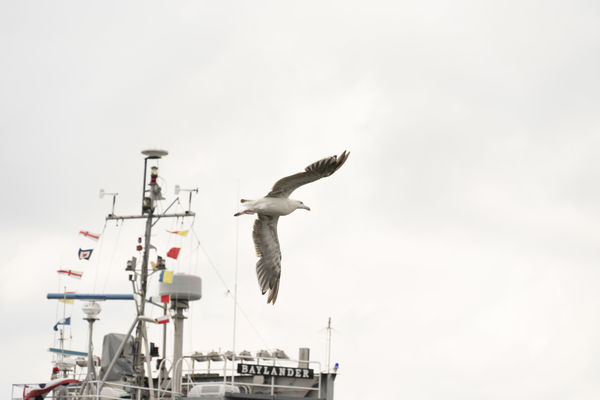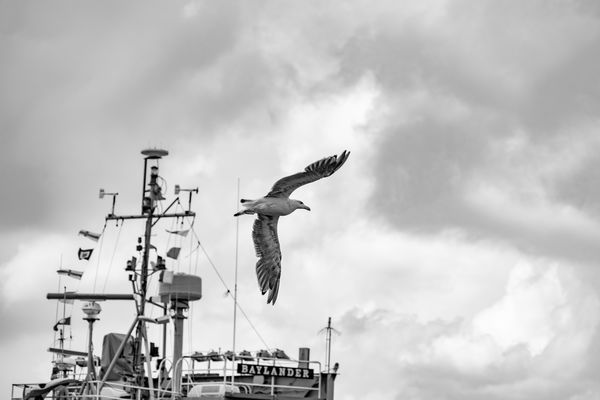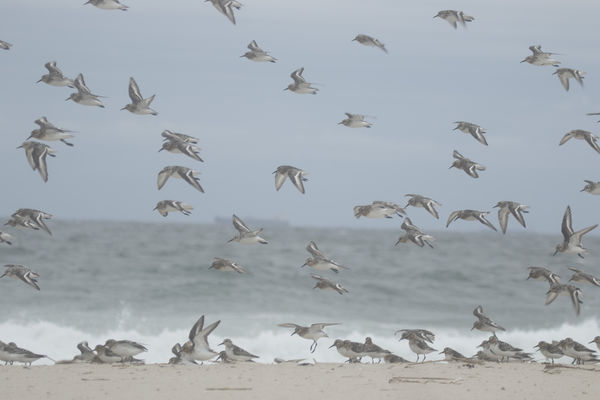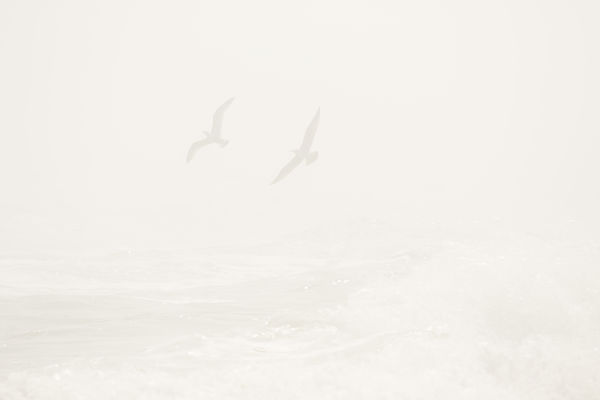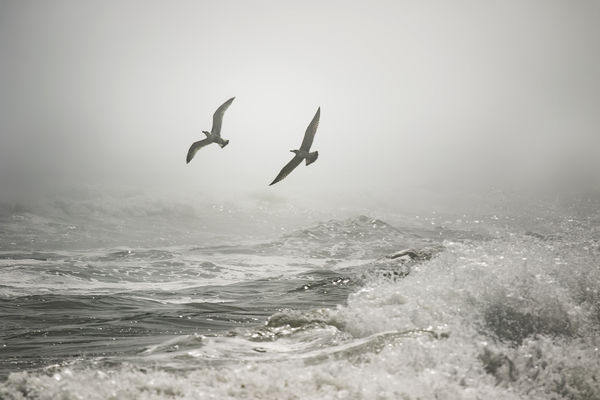Overexposed
Aug 13, 2018 20:43:09 #
Hi everyone! Yesterday I photographed birds with my Sony A7rii. The day was fuggy and humid. Almost all my photos of birds are underexposed. Just ugly. I shoot in RAW so I recovered most of them. But I can't figure out setting to photograph birds in this weather. What did I do wrong? Please advise. Thank you.
Aug 13, 2018 20:56:01 #
Aug 13, 2018 21:00:05 #
Aug 13, 2018 21:07:09 #
It's not the first time it happened. I was on the Jones beach when it was very muggy and humid overcast day. The ocean was pearly gray and exceptionally beautiful but I had the same underexposed ugly photos.
Aug 13, 2018 21:24:31 #
If you metering points happen to fall in between the birds (mostly), it will try to expose for the sky (background), thus under exposing the birds. Spot metering and lock it on a bird? I never tried flying birds.
How does averaging work?
How does averaging work?
Aug 13, 2018 21:28:25 #
The EXIF data on the first images says you're in manual exposure mode. When you adjust your shutterspeed, aperture and ISO, what drives your decision? If you're just setting / adjusting the meter to '0', that is the source of your problem.
A 'good' speed for birds in flight is 1/1000, you should start there. Depending on the distance to the bird and focal length of your lens(es), you probably should work at f/8 to f/11. Then, adjust your ISO so you're pushing the exposure to +0.7 to +2 stops over the camera's 'zero' reading. Use your highlight warning (blinkies) to tell you if / where you're overexposing. Assuming this first image has been edited, look at the histogram and how the color and brightness readings are all pushed to the right. That's where the histogram should have been reporting on the camera as you captured the images.
I use a different Sony model, an A7II. My best results meter at +0.7 to +1.3 from the camera for RAW files then edited in Lightroom.
A 'good' speed for birds in flight is 1/1000, you should start there. Depending on the distance to the bird and focal length of your lens(es), you probably should work at f/8 to f/11. Then, adjust your ISO so you're pushing the exposure to +0.7 to +2 stops over the camera's 'zero' reading. Use your highlight warning (blinkies) to tell you if / where you're overexposing. Assuming this first image has been edited, look at the histogram and how the color and brightness readings are all pushed to the right. That's where the histogram should have been reporting on the camera as you captured the images.
I use a different Sony model, an A7II. My best results meter at +0.7 to +1.3 from the camera for RAW files then edited in Lightroom.
Aug 13, 2018 21:35:03 #
I tried spot metering but it came out junk. When I shoot the entire scene it just looses all details. It was a horrible experience.
Aug 13, 2018 21:39:10 #
irinaescoffery wrote:
It's not the first time it happened. I was on the Jones beach when it was very muggy and humid overcast day. The ocean was pearly gray and exceptionally beautiful but I had the same underexposed ugly photos.
To properly expose this image in RAW for subsequent processing, look at where the 'whites' are located. The surf and the whites of the bird's wings should be blinking as highlight warning as you meter and determine the best exposure (shoot and review the test image(s)). See my earlier comment about 1/1000 for the shutter. In this image, you might focus on 1 individual bird at f/5.6 to f/8 or narrow to f/11 to try for all birds in the frame in focus together. Adjust your ISO to "push" the ISO to keep the meter at +1 to +2, using the highlight warning indicator to refine the specific value needed for the situation.
Aug 13, 2018 21:40:56 #
Thank you for your reply. Shutter speed for seagulls can be a little slower that 1000, I think, as they are pretty slow birds. But the problem is not birds themselves. They are sharp enough as you can see. But the sky is just washed out. Should I make shutter speed higher for just make the sky better exposed?
Aug 13, 2018 21:42:57 #
I see what you are saying. It makes more sense to me now. Thank you. It was valuable advise. I will do it next time. Thanks a lot.
Aug 13, 2018 21:44:24 #
irinaescoffery wrote:
I tried spot metering but it came out junk. When I shoot the entire scene it just looses all details. It was a horrible experience.
Use evaluative meeting on the Canon model and the corresponding Sony metering that assesses the entire frame for exposure. Then, use your highlight warnings to assess the areas blinking. Use the meter in the view finder to tell you how far to the right your exposure is taking you when you get the blinkies to either be "just" removed or blinking on non relevant areas. Then, as you change directions (light) or further adjust the shutter or aperture, make the corresponding adjustments to the other sides of the exposure triangle to keep meter at the same position.
Aug 14, 2018 08:59:15 #
If you meter with spot metering from a bright area and you correct the exposure you should not have the problems you are having. Evaluative, matrix or similar meters do not do as well under those conditions.
If you try to use spot metering in manual mode while the birds are in flight you will have lots of problems with the exposure so it is important to meter in advance for the conditions you encountered and be prepared for when the action takes place.
Foggy scenes should not be a problem either, meter from the fog and open one stop for the correct exposure.
If you try to use spot metering in manual mode while the birds are in flight you will have lots of problems with the exposure so it is important to meter in advance for the conditions you encountered and be prepared for when the action takes place.
Foggy scenes should not be a problem either, meter from the fog and open one stop for the correct exposure.
Aug 14, 2018 10:21:59 #
miket22
Loc: Northern Massachusetts
Dark birds against a light sky usually get underexposed. Light or white birds on a dark background usually overexposed or blown out. You can compensate with plus for the dark birds and minus for the light or white birds. Birds in flight you need to have 1/800 or less - shorter exposure time to minimize blur. Sorta working with 2 variables here.
Aug 14, 2018 12:23:47 #
irinaescoffery wrote:
I tried spot metering but it came out junk. When I shoot the entire scene it just looses all details. It was a horrible experience.
From what you've posted you seem to be successfully recovering the shots. The high dynamic range of the scenes pretty much guarantees that they won't look right straight out of the camera, because in reality the sky is very bright and the birds are relatively much darker. It's never going to look right SOOC, and any similar successful shots that you've seen from others will be a product of careful post processing.
Using positive exposure compensation may give better exposure for the birds but there is a severe risk of blowing the bright sky/clouds. I get the impression that the exposure in Sony cameras gives priority to safeguarding the highlights - which makes sense because blown highlights will spoil a shot whereas underexposure, while not being optimal as far as the dark subjects are concerned, can be corrected in PP. The extra raw available dynamic range (ERADR) of the camera provides a safety buffer exposure-wise, but it's very difficult to gauge by eye just how much of a risk there is of blown highlights, and as a consequence, positive exp. comp. is a risky tactic. In your situation I would just trust Sony's clever metering and brush up on my PP skills so that I could optimise the brightness levels in post.
Aug 14, 2018 12:48:57 #
Stay on M. Use auto ISO (limit to 6400) and use auto WB. Select your aperture usually f8-f16. Use the shutter speed adjustments to get proper exposure. As the light changes so will your shutter speed.
If you want to reply, then register here. Registration is free and your account is created instantly, so you can post right away.

